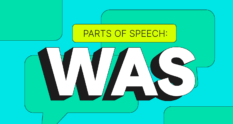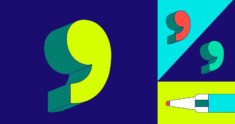
Most of the punctuation marks we know and love have been around for centuries, but can you believe that’s not the case for the wild and whimsical interrobang‽
Invented in 1962, this punctuation mark combines the exclamation mark and the question mark into one fancy doodad. Although it’s lesser known than most punctuation types and not often used, it’s a fun trick you can use to convey a question in an excited and energized way.
But what does the interrobang do? And how can you use it to spice up your writing? Let’s interrogate the interrobang so you can give your writing a little extra flair.
What is an interrobang?
An interrobang [in-TER-eh-bang] is a nonstandard double punctuation mark that combines the functions and glyphs of an exclamation mark (!) and a question mark (?) into one form: ‽. It indicates a sentence that is both a question and an exclamation, expressing surprise or disbelief.
The interrobang gets its name from the punctuation it’s intended to combine—interro is from “interrogation point,” the technical term for question mark, and bang is printers slang for the exclamation mark.
Superimposing both punctuation marks into a single glyph signifies an exclamatory sentence that is a question. This means the interrobang is best used to end a rhetorical question or conclude a simultaneous exclamation and question. It is sometimes called an “interabang” or “exclamation question mark.”
The word interrobang was coined by advertising executive Martin K. Speckter. Frustrated with copywriters’ tendency to combine exclamation and question marks to yield a surprised or rhetorical question, he offered a solution to replace this “ugly, jury-rigged construction,” and the interrobang was born.
You’ve likely come across the improvised punctuation before, written simply as a back-to-back exclamation mark and question mark, like this: !? or ?!
Still, this is the only way to employ the interrobang in everyday writing, as there is no dedicated key for the glyph on standard keyboards. As such, most writers continue to communicate the sentiment the interrobang expresses by using !? or ?! concurrently, just as they did before the mark’s official invention.
When to use an interrobang
Since the interrobang has such a quirky punctuation personality, it can be challenging to know when it’s appropriate to use one. However, if you enjoy using unique and expressive punctuation, this offbeat character has obvious appeal.
The interrobang will always come at the end of a sentence. Most often, interrobangs are used to convey a sense of surprise or disbelief or a combination of both in the form of a question. It adds energy to a question, resulting in either shocked incredulity (“She said what to Martin‽”) or an excited inquiry (“They won a trip to Spain from a radio show‽”).
Still uncertain about when it’s appropriate to use the interrobang? Here are three cases when it makes sense to use this combined character:
1 Rhetorical questions with emphasis: Interrobangs are ideal when you’re asking a rhetorical question that is meant to be particularly emphatic. They can add a visual cue to communicate extra intensity, as in “What were you thinking‽”
2 Combining a question and an exclamation: If a statement is both a question and an exclamation, the interrobang can represent this dual nature, as in “You published a book‽”
3 Expressing strong emotion: Interrobangs are especially appropriate when you want to convey a heightened sense of emotion or astonishment, as in “He really said that about his own child‽”
Although the interrobang is certainly a fun and expressive mark of punctuation, it’s crucial to note that it is not a standardized form, and some style guides and formal scenarios may discourage its use. If you decide to use one, make sure you’re aware of your audience and that it’s apt for the context.
How to include an interrobang
Since the interrobang is not included on standard keyboards, learning how to type one takes a little extra effort. Here are several ways to write or type an interrobang:
Write an interrobang: If you are putting pen to paper, writing an interrobang is easy. First, write a traditional question mark at the end of your sentence. Then, draw a straight line through it to signify the exclamation mark. No second period or point is needed!
Type an interrobang with Google Docs: Under the “Insert” menu select “Special characters” and then search for “interrobang: in the search bar. Click the glyph to insert in your text.
Type an interrobang with Unicode: If you use Unicode (the text-encoding standard where each letter, digit, or symbol is assigned a numeric value), you can easily type interrobangs. Simply use the code U+203D. This can be achieved by pressing the Alt key, then pressing the plus sign (+) key, and typing the code U+203D. Release the Alt key, and your interrobang should appear.
Typean interrobang with the Character Palette in macOS: You can readily find an interrobang symbol on the Character Palette, which is included on macOS. To do so, press the Ctrl key, then press Cmd, and then press the space bar. This will open up a menu with various emojis and symbols. Type “interrobang” into the search box, select the interrobang symbol, and this will add it to your document.
Typing an interrobang without any key code: If you are unable to employ a key code through Unicode or through the macOS Character Palette, you can still include an interrobang by copying and pasting it from another document or web page. Simply highlight the glyph, right-click it, copy it, and then right-click again in your document to paste it.
Interrobang examples
To make things even clearer for you, let’s take a look at several sentence examples where interrobangs are used correctly.
- Henry’s leaving the company after only two months‽
- What do you mean you lost the keys to my apartment‽
- Why on earth would Wendy do that‽
- You’re telling me you’ve never seen an episode of Seinfeld‽
- How could you forget our anniversary‽
- Dad ate the last slice of pizza after I told him I wanted it‽
- You’re really wearing that to the party‽
Interrobang FAQs
What is an interrobang?
An interrobang [in-TER-eh-bang] is a nonstandard double punctuation mark that combines the functions and glyphs of the exclamation mark and question mark into one form: ‽.
When do you use an interrobang?
The interrobang is written as a single character that is used to indicate a sentence is both a question and an exclamation, expressing surprise or disbelief. Appearing at the end of a sentence, interrobangs add energy to a question, expressing either shocked incredulity or an excited inquiry.
How do you type an interrobang?
You can type an interrobang by using the text-encoding standard Unicode, which is built into many computers, or by using the character palette in macOS on your computer, tablet, or phone. You can insert it in Google Docs in the “Special characters” option, or simply copy and paste an interrobang from another document or web page.






